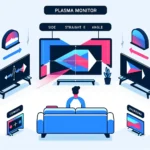The Evolution of Plasma Monitors
Plasma monitors have been a significant part of the display technology landscape for many years. Known for their rich colors, deep blacks, and wide viewing angles, plasma screens were once the gold standard in large-format displays. However, with the rapid advancements in display technology, other types of monitors, such as LCD and OLED, have become more prominent.
Key Features of Plasma Monitors
| Feature | Description |
|---|---|
| Image Quality | Rich colors and deep blacks |
| Viewing Angles | Wide and consistent |
| Response Time | Fast, less motion blur |
| Brightness | Good but not as high as LED |
| Weight | Heavier than LED and LCD |
Touchscreen Technology
The introduction of touchscreen technology has revolutionized the way we interact with our devices. From smartphones to tablets and interactive kiosks, touchscreens offer a user-friendly interface that enhances the overall user experience. This technology uses a variety of methods, including resistive, capacitive, and infrared, to detect and respond to touch inputs.
Types of Touchscreen Technology
There are several types of touchscreen technology, each with its unique advantages and drawbacks:
- Resistive: Cost-effective and works with any input device, but less sensitive and accurate.
- Capacitive: Highly sensitive and accurate, supports multi-touch, but requires a conductive touch (like a finger).
- Infrared: Highly durable, used for large screen formats, but can be prone to false touches from external light sources.
Combining Plasma and Touchscreen Technology
Integrating touchscreen capabilities into plasma monitors poses several challenges. Plasma displays are relatively heavier and thicker than their LCD and LED counterparts, making the integration of touch-sensitive overlays complex. Moreover, the heat generated by plasma technology can affect the performance and reliability of touch sensors.
As a result, plasma monitors with touchscreen capabilities are not commonly found in the market. Manufacturers have shifted their focus towards more adaptable technologies like LCD and LED displays when it comes to touch integration. These technologies are lighter, thinner, and generate less heat, making them more suitable for interactive applications.
Why Plasma Monitors Struggle with Touchscreen Integration
- Heat Generation: Affects touch sensors’ performance.
- Weight and Thickness: Makes integration challenging.
- Market Shift: Focus has moved to more adaptable technologies like LCD and LED.
Current Market Availability
In today’s market, the availability of plasma monitors, especially those with touchscreens, is extremely limited. The production of plasma displays has significantly declined due to the rise of more energy-efficient, lightweight, and versatile LED and OLED technologies.
Manufacturers like Panasonic and Samsung, once leaders in the plasma market, have ceased production of these displays entirely. Instead, they offer a wide range of LED and OLED screens, many of which come with integrated touch options.
Comparing Plasma with Other Display Technologies
To understand the current landscape, it is essential to compare plasma monitors with other prevalent display technologies:
| Aspect | Plasma | LCD/LED | OLED |
|---|---|---|---|
| Image Quality | Excellent | Good | Outstanding |
| Touchscreen Integration | Complex | Easy | Easy |
| Energy Efficiency | Moderate | High | Highest |
| Weight | Heavy | Light | Light |
| Lifespan | Shorter | Long | Long |
Conclusion
While plasma monitors were once at the forefront of display technology, their inherent characteristics make them less suitable for modern touchscreen applications. The market has largely transitioned to LCD, LED, and OLED displays, which offer better integration with touch capabilities, improved energy efficiency, and a slimmer form factor.
For those looking for touchscreen monitors, it is advisable to explore LCD and LED options, which provide a more reliable and practical solution. Though plasma monitors still hold a place in niche applications, their era as mainstream technology has largely passed.


